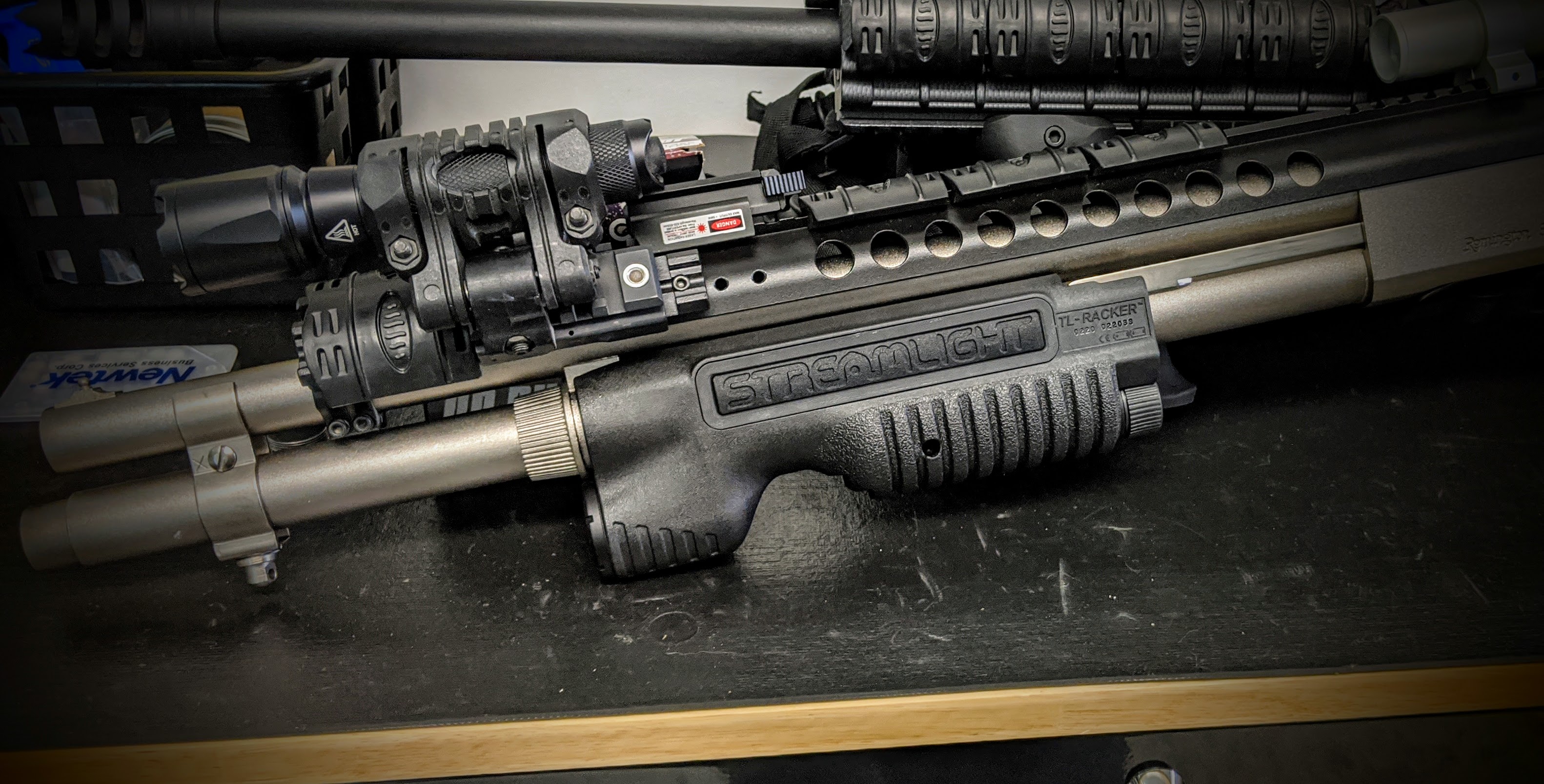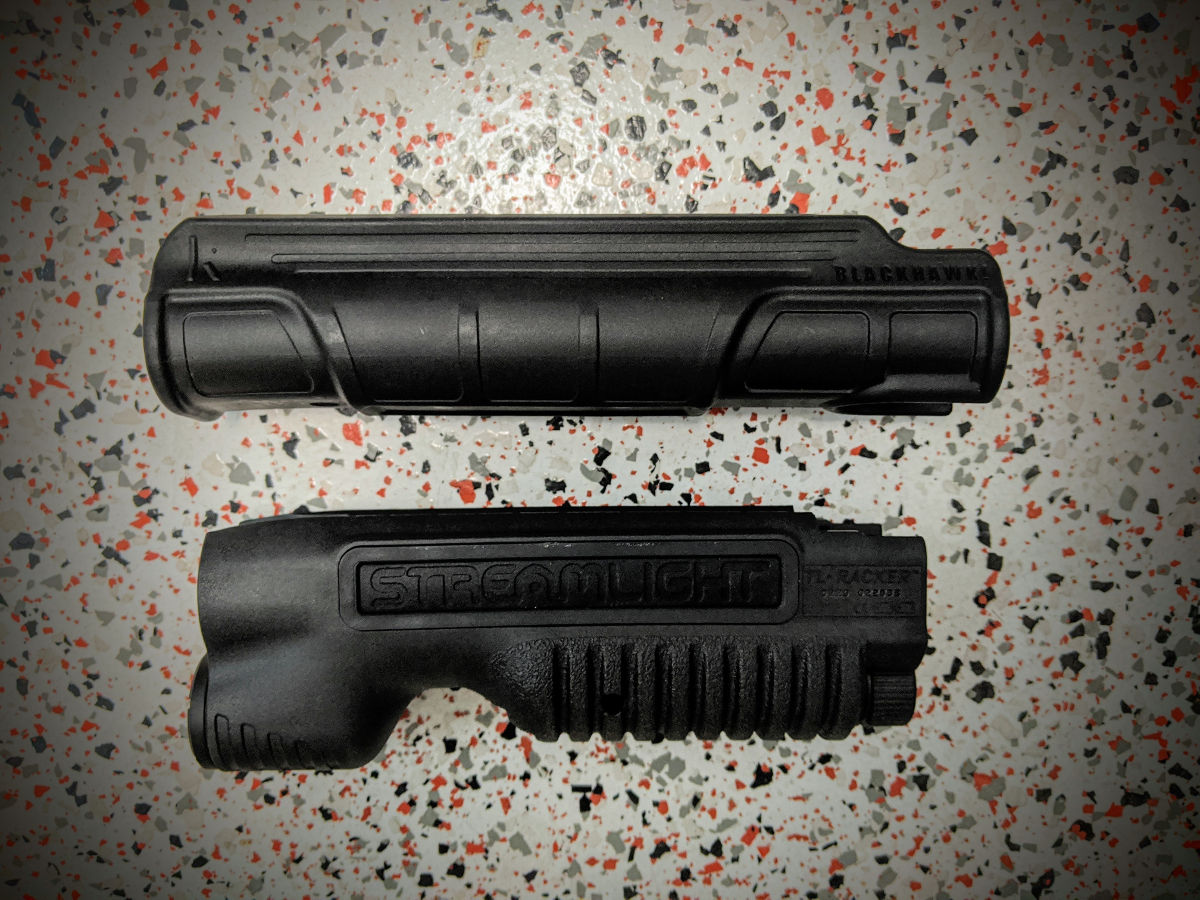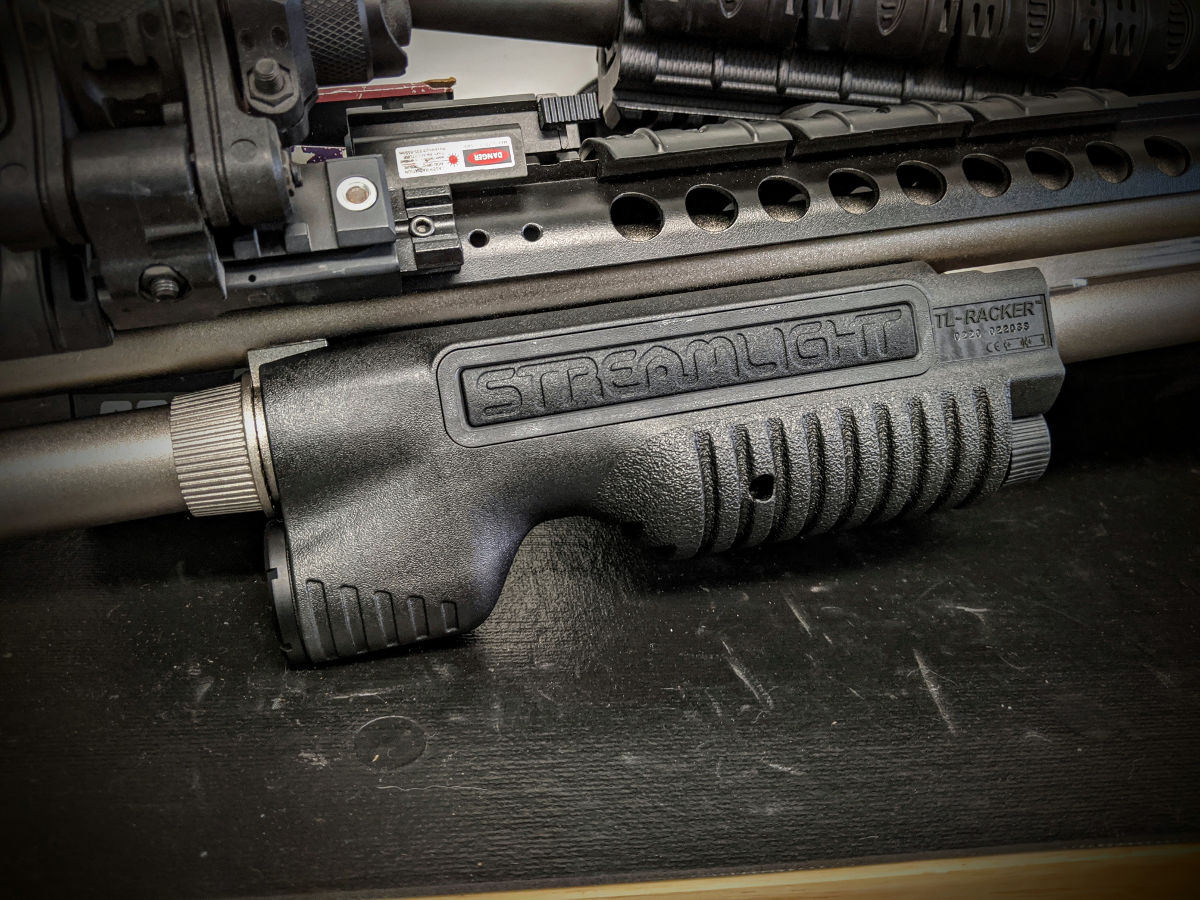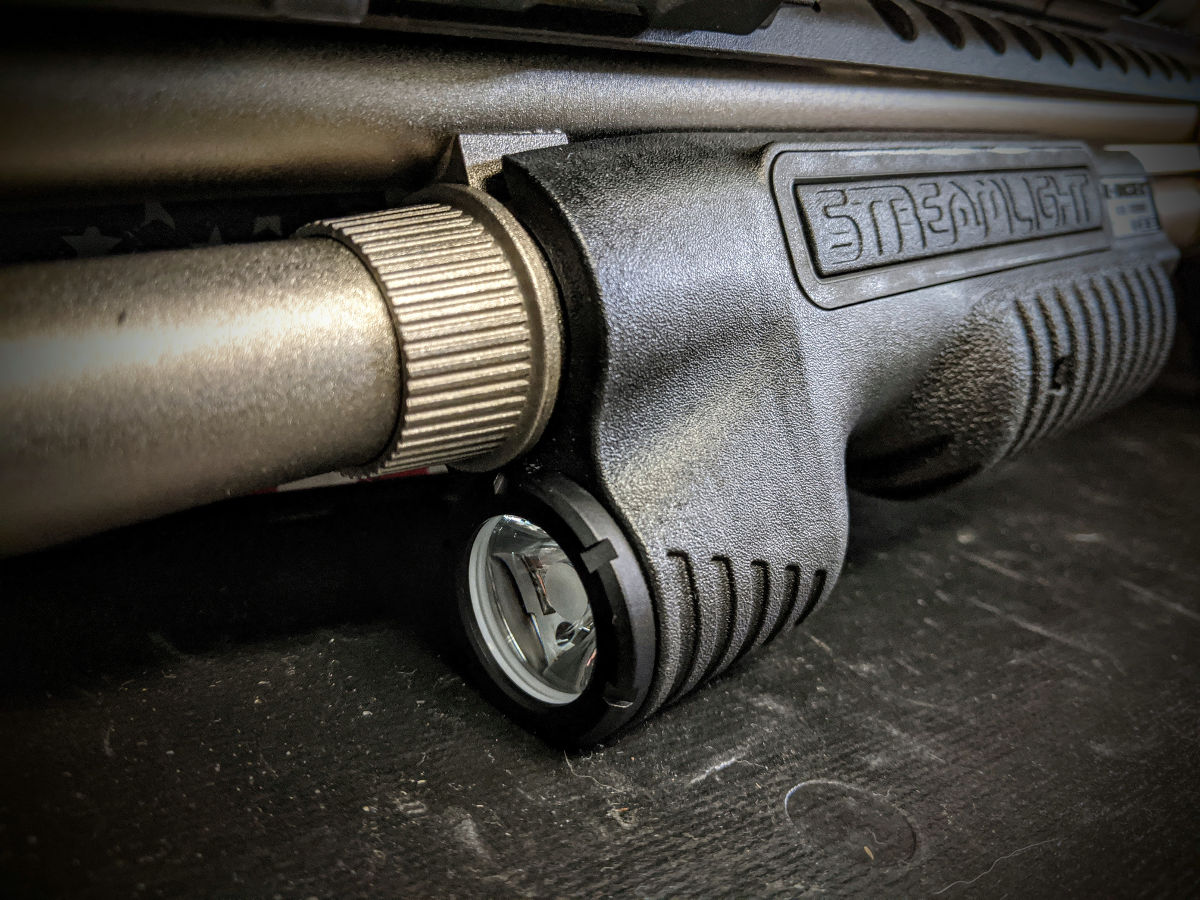A Review of the Streamlight TL-Racker Shotgun Forend Light on the Remington 870 Marine Magnum
Posted by AJ Koenes on Apr 17th 2020
Where to Buy the TL-Racker Shotgun Light
The TL-Racker can be purchased from eBay for whichever series of shotgun you have.
Buy on eBay
First Impressions of the TL Racker Shotgun Forend Light
I was first introduced to this product at Shot Show 2020 in Las Vegas. We had a meeting with one of the representatives from Streamlight where she went through some of the newer products they were offering to the market among a few of the more mainstream products.
Their TL-Rackers stood out to me because I have a Remington 870 bedside gun for self-defense. I was able to mess around with the light a little bit during the meeting and intuitively, it did not make the most sense. I could see how it could be a good product, but without actually having it installed and deployed, it was difficult imagining how well it would work. The buttons seem to be a little finicky and there were no instructions on how to use them. The features were lacking in description and by itself, the forend didn't feel the nicest in the hand. It felt like a big piece of plastic, which it essentially is.

Installation of the TL-Racker onto a Remington 870 Shotgun
Now I had a Blackhawk Knoxx stock and forend currently installed on my shotgun so I had replaced the forend before. The process, from what I remember, is pretty straightforward and the instructions in the box made it pretty easy to follow.
What you need
Now, in order to install the forend while keeping the bolt and the bolt carrier inside the receiver, you will need a spanner wrench. My installation method opted for not using a spanner wrench since I don't have one. The process of installing it without a spanner wrench is pretty straightforward if you have a diverse selection of pliers.
How to install
- Essentially you take the magazine tube off, remove the barrel, and then you slide off the current forend and the action bars that connect it to the bolt and bolt carrier.
- Once you have the forend, the action bars, the breech bolt, and the slide removed, you should be able to slide a pair of needle nose into the front of the forend while lining them up with two notches on the forend tube nut.
- Once you have each half of the pliers inserted into the notches, you can rotate the pliers, loosening the forend tube nut.
- Once it's off, you simply slide the forend off, put the new forend on, and retighten the forend tube nut exactly reverse of the way you took it off.
- Then you slide the whole assembly back into the receiver.
- Once you get aligned up properly, it'll only go in a quarter of an inch. There is a right and left shell latch that you have to depress to finish inserting the forend assembly and breech bolt back into the receiver. Once you depress one side, the assembly will go in another half inch and then you depress the other side to fully insert the assembly.
- The rest of the process finishes by reassembling the barrel, accessories and then tightening back on the extension tube with the magazine spring and such installed in the same way that you removed it.
Overall, the process was pretty simple. In my assembly process, I realized that I should clean the entire thing. I loosened to the buttstock and removed the trigger assembly so that I could properly clean all the components of the shotgun. I then assembled it back together, ensured that it functioned.
How long it took
The process will likely take 20 minutes if you've done it before, 30 minutes if you've never done it before. In my case, it took an hour because I did a complete disassemble, cleaned all the components, and then reassembled everything back into the receiver.

The Specs on the TL-Racker Shotgun Forend Light
Now the product specifications are quite impressive.
It comes boasting a max of 1000 lumens, which is shocking considering the small size of the bulb. Run time to achieve a 1000 lumens brings you down to only 1.5 hours, which should be more than enough to clear a house. If you're proficient, you should be able to clear an entire warehouse in an hour and a half. They brag that the beam distance is 283 meters and the max candela is 20,000. It takes 2 CR123A lithium batteries that are supplied with your purchase. The entire length is 8 inches and weighs slightly over 12 ounces. Interestingly enough, it does come in 2 different colors, black or orange.
The reason they released a bright orange forend is for law enforcement agencies that deploy less than lethal shotguns in the field. To my understanding, an officer may have a green or orange shotgun in their inventory, which is only used for less than lethal rounds. The orange quickly identifies the shotgun for this specific use and helps differentiate it from the common lethal shotguns that you typically see in most squad cars. I forgot to mention earlier that even though I have this installed on a Remington 870, they also make these forends for the Mossberg 500 and 590 series along with a Mossberg 590 shockwave. Incidentally, I believe Remington 870 will also work with their AOW model of the 870 but I cannot confirm that at this point.
The Field Tests of the Streamlight TL-Racker Shotgun Forend Light
The field tests were pretty astonishing going in. I was rather skeptical on their boasts of the light, so I had a 500 - 600 lumen Phoenix that I had previously installed on the shotgun used in conjunction with the new forend light. Once I had installed the light and I was testing it, I could tell that a TL-Racker was indeed bright and produced a nice vibrant, slightly blue beam that worked well for identification. Once I turned on the Phoenix light in conjunction with a TL-Racker, I noticed a slight improvement while running both flashlights at the same time. Once I disabled the TL-Racker it was blatantly obvious that the Phoenix, even though a bright, durable, and well-respected tactical flashlight, was only about half as bright as the TL-Racker I just installed.
Through my tests, I ran a series of functional exercises to become acquainted with the new forend light. There weren't very many instructions on its operation, but once it was installed, it was pretty evident how it operated. A short crisp click on the button would turn the light on indefinitely without any more user intervention. Another short crisp click would disengage the light. Now, if you held the button for longer than roughly half a second, the light would disengage immediately upon release. It was apparent how beneficial this would be in a tactical situation. The design of the switch was intuitive and with a little bit of practice, you could easily manage your flashlight in any type of scenario.
In no time at all, I was able to effectively engage the light when I wanted it on indefinitely, disengage it when I wanted it off, and then use it to engage only when I was holding the button. Comparing this to the Phoenix flashlight I had used on the same shotgun previously, it was much more intuitive, a lot easier to use. It aided greatly in the exercises for evaluating the light.

Pros of the Streamlight TL-Racker Shotgun Light
The pros of this light are that it's simple, effective and easy to use. To elaborate more on that, it's a simple light. It has a button on the left and right-hand sides. For my particular hand size, it works well to use my thumb on the left-hand side. Somebody with a larger hand in a different grip would find it beneficial to use the switch on the right-hand side. Both switches work the same way and they're positioned in an easy to use way. The light is brighter than any light I've seen before. It's effective in clearing out small to large houses, warehouses, and even for use outside due to its nearly 300-meter range.
Now because this is a forend, I do need to evaluate the ergonomics on the shotgun. Previously I had a Blackhawk Knoxx forend that I installed in conjunction with the recoil-reducing stock. I did this to evaluate if the Knoxx forend would make a difference. The Blackhawk was definitely an improvement to the shotgun. It's thinner, sleeker, lighter and made racking the shotgun fast and effective. It turned a regular old 870 into a speed demon and for my hesitance in installing it, I'm glad I installed the Blackhawk Knoxx forend.
Of course, I had to switch that out to install the TL-Racker Shotgun forend Light and in doing so the shotgun did take on different characteristics. I can tell you the Streamlight ergonomics are superb and work well with the 870. The oversized grip on the forend is easy to grab, the texturing is not as secure and does not have as much grip as the Blackhawk. The indentation in front of the Streamlight foregrip and behind the light allows for a nice pocket to put your index finger while wrapping around the foregrip and gave substantially in control when racking the action on the shotgun.
The Streamlight TL-Racker is a bit heavier than the Blackhawk. What the TL-Racker lacks in speed, it makes up in positive mechanical feedback. What I mean by that, is to say that when you rack the action in the TL-Racker, you're not guessing whether the action is open, closed or somewhere in between. Rather than taking on the speed of a singular action movement, it takes on the nuances of having controlled feedback in your action.
There was positive mechanical feedback when you initiate the slide backward, which continues until it stops. Once you initiate the action forwards, there's no feedback until the breach stops and then there's a definite change as well as an audible change in the action while the breach locks. To paraphrase, it would be the difference between using a throttle cable and a throttle wire.
If you're familiar with automobiles, the older vehicles had a cable that ran a carburetor, whereas the newer vehicles tend to be run with electrical impulses. If you remember, the older throttle cable would allow you to feel how your engine is running and how far open the butterflies were in the carburetor while you were driving, allowing you positive feedback from your engine.
This is similar to how the TL-Racker feels on a shotgun. The newer fly by wire systems only sends electrical impulses between your foot and the engine because you can't feel these electrical impulses. You lose the ability to gauge your engine by the amount of pressure or the feedback traveling through the gas pedal, that would be similar to the way the Blackhawk forend felt on the Remington 870 shotgun. In essence, they both function the same way and they both function very well. I would say the TL-Racker benefits its user in giving the user feedback, whereas a Blackhawk benefits in speed due to its light design.

Cons of the TL-Racker Shotgun Forend Light
Though I was thoroughly impressed and enjoy using the Streamlight TL-Racker, there is one thing that does frustrate me with its simplicity. That is that the TL-Racker does not have a strobe function. I am a big proponent in less than lethal and alternative means to self-defense. A strobe can be crucial in disorienting an assailant without ever having to fire a shot. It's to this effect, that I'm disappointed that Streamlight has not built this functionality into their forend light.
I do agree that the design of the light proves a bit difficult in providing such functionality and I'll also add that it can be argued that the brightness of the flashlight mitigates the need for a strobe. In essence, what I'm saying is the TL-Racker Shotgun forend flashlight is so bright that I believe it would disorient any assailant regardless of whether or not it is strobing.
One thing to consider though, not necessarily a con, would be the grip of the TL-Racker. It's easy to manipulate with one hand but the grip texture on the forend does not give me confidence when yielding the shotgun by the foregrip with a single hand while sweaty. I would have preferred that the gripping was a bit more aggressive to help your hand connection while manipulating the action.
The Final Thoughts for the TL-Racker Shotgun Forend Light
My final thoughts on this light are superb. Other than the lack of a strobe feature, I love everything about it. It has transformed my 870 from a bedside shotgun speed demon that can pump out a clip in under 10 seconds, to a precise and well-tuned self-defense firearm. The ergonomics allow better grip control and aiding in tighter follow up shots. The speed of racking the shotgun is more than sufficient. The positive mechanical feedback tells me whether or not the action is open, closed or locked. The brightness of the flashlight is astounding. It is comparable to a flashlight versus a spotlight. The broad, wide beam is wide enough to allow for peripheral vision around a room during entry. This is something that older flashlights simply do not have. Many of my older flashlights have a more direct and precise beam. The Streamlight TL-Racker doesn't need it because it's so bright. Due to this brightness, they can widen up the beam angle allowing you to see more around you and not just what's in front of you. The button placement is excellent. The buttons are easy to use and very large. The buttons are also easy to activate from many different positions. The batteries are easy to replace and the run time is sufficient for its purpose.
Overall, I'm very happy with this flashlight and consider it a vast improvement over the previous setup which was Phoenix 500 lumen flashlight in conjunction with a Blackhawk Knoxx forend.
Affiliation Disclosure: This post contains affiliate links. If you make a purchase, we may receive a commission. This won't affect your purchase price.
